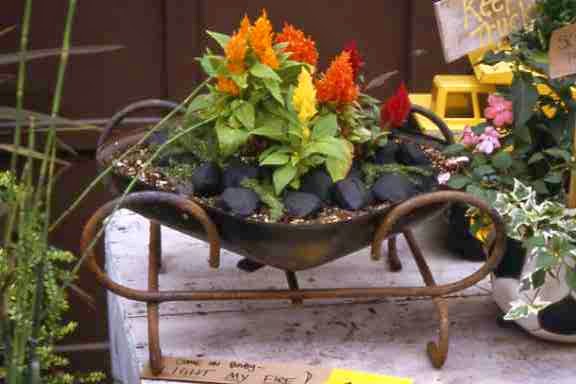 |
| A few flame-orange and fiery-red Celosias inside and add charcoal briquettes as “mulch" - Debra Prinzing |
Saturday, May 30, 2015
Firepit container inspiration
Thursday, May 7, 2015
Summer Garden in St Petersburg

1. Neva entrance.2. Fontanka Entrance.3. “Peace and Victory”, the only remaining original marble sculpture.4. “The Habanero”.5. Krylov Monument.6. Bird House and Sable Cages.7. Central Alley.8. Pond.9. Wi-Fi Zone.10. Lacoste Fountain.11. Small Winter Garden and Apothecary Garden.12. Coffee House.13. Peter the Great’s Summer Palace
The Garden has three parallel alleys leading from the Neva river into the Garden, crossed by several perpendicular paths. To the north and the east, the Garden is naturally bordered by Neva and Fontanka rivers. To the south and west, the Garden is bordered by the Swan Canal and the canal connecting Fontanka to the Moika river.
The northern part of the Garden, which adjoins the Palace and is decorated more richly, was the First Summer Garden. The southern part, with garden amusement facilities, administrative buildings and a fruit orchard, was the Second Summer Garden.
The sides of the alleys in the Summer Garden, were planted with evenly edged bushes creating green walls known as espaliers.
Four bosquets bounded by the walls of espaliers contained various garden amusement facilities. In one of the bosquets, was oval Menazhery pond, with a small island with an arbor.
Another bosquet contained a Poultry-yard, with a dovecote and houses for birds.
The Cross Walking Place bosquet was crossed by criss-cross enveloping roads, and a single-steam fountain with sculpture in the centre.
The French Parterre bosquet was adorned with gilt sculpture, a cascade, and a flower garden.
The alleys of the First Summer Garden were decorated with marble statues and busts brought from Italy. Fountains gushed on the grounds of the central path. At the Fontanka bank, a Grotto pavilion was built.
A large part of the Second Summer Garden was occupied with the Labyrinth, with fountains decorated with gilt leaden sculpture groups depicting the plots of Aesop's fables.
The flood of 1777 caused serious damage to plantings, statues, and fountains in the Summer Garden. Catherine II employed architect Y. Felten to created new decoration for the Garden including the railing placed along the Neva embankment.
In the nineteenth century, the Garden continued to develop as a public city park "for decently dressed public". By order of Emperor Nicolas I, impressive changes were introduced. In 1826, Carlo Rossi transformed the remains of the Grotto into the Coffee House. In 1827, the Tea House was built not far away from it.
In 1839, the porphyry Elfdahlen Vase, a present from the Swedish King Carl Johann XIV to Nicolas I, was placed at the south entrance.
The last major restoration work on the Summer Garden was carried out between 2009 and 2012, restoring its geometrically regular layout and strict symmetry. Espaliered linden shrubs appeared in 2009, with the support structures removed three years later, in 2012. Today, the garden is mainly planted with linden, maple, elm, oak, and ash, with about 30% of them over 100 years old. Ninety out of ninety one sculptures were replaced with copies made of marble chips and polyester resin because marble busts and statues were getting damaged by dripping linden tree juice.
Friday, May 1, 2015
Moscow's Muzeon Park of Arts
The open-air museum of sculpture now known as Muzeon Park of Arts is located on the Krymsky Val (Crimean quay), outside the House of Artists and the modern art division of Tretyakov Gallery. It was created by Government of Moscow and Committee on culture of Moscow in 1992. Originally called “the Park of the Fallen Heroes” and later well known as “Fallen Monument Park”, it is the final resting place for the many Soviet statues removed from Russia’s parks and squares following the collapse of Communism. It now contains more than 700 works made of a stone, bronze, wood and other materials, including some notable pieces by Vera Mukhina, Ivan Shadr, Yevgeny Vuchetich, Yevgeny Chubarov. Highlights include the huge steel sculpture of the Soviet world, innumerable giant pedestal-less Lenins, monuments to the Red Army, and a de-nosed Stalin. In 2013 the Krymskaya embankment became a pedestrian zone and part of the Muzeon park.
| Working Woman's Portrait |
 |
| Oleg Garkushenko, "The Return of the Prodigal Son", 1998 |
| "Gather stones", Oleg Garkushenko, 1995, metal, granite |
| More than 80 works of liimestone created between 2000 and 2011 in open air sculpture workshops. |
 |
| BustS of Joseph Stalin (left) and Vladimir Lenin (right),Soviet emblems in the background. |
Subscribe to:
Posts (Atom)









